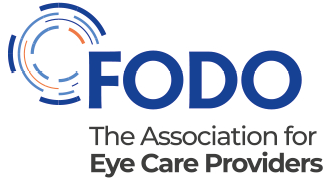- Introduction to patient choice
- About this guidance
- The right to choose an ophthalmology provider
- FAQs
- Example of patient choice in practice
- Regulation and compliance
- Provider-led CPD (coming soon)
- Other resources
Introduction to patient choice
Patient choice is one of the fundamental principles underpinning the success of primary eye care, which today delivers modern, high-quality and accessible services to the whole population [1]. The fact that patients can choose to attend any practice for a sight test, spectacles or contact lenses, with funding directly following the patient, has also driven investment, modernisation and innovation for all, with high levels of outcomes and patient satisfaction and few patient or regulatory complaints [1-2].
Elsewhere in healthcare, we know that where patients have genuine choice, services improve and are organised around patients, not systems or clinicians, and result in efficiency and productivity gains.
This is why FODO, the association for primary eye care providers, is committed to protecting and promoting patient choice for the benefit of all patients [1].
With the NHS England nationwide rollout of direct referral from primary to secondary eye care services [3], we now have an opportunity to ensure more patients also benefit from a choice of ophthalmology provider. We will support members translate this policy into practice, starting with this initial guide on patient choice in England.
In addition to this guide, FODO, on behalf of its members who provide over 80% of primary eye care and hence the majority of referrals to ophthalmology, will also continue to work to secure access to a consistent IT connectivity solution (e.g. the NHS e-Referral Service (eRS)) so that referring practitioners can access the information they need to help patients make informed choices about where and when they want to access secondary eye care services.
About this guidance
Optical practices in primary care are the first port of call for people with a concern about their vision or eye health. This results in 95% of patients needs being met in primary eye care, with only 3-5% referred on to hospital for a medical opinion [1].
Historically, many of these referrals had to go via a GP but with ever greater pressure on health services and funding, the NHS needs to support GP colleagues to free up capacity so they can focus where they are needed most. FODO has therefore welcomed the national implementation of direct referral from primary eye care to ophthalmology in England [3].
Direct referral to ophthalmology will also help avoid administrative delays which can arise from the involvement of third-party referral management systems and ensure patients are referred with the appropriate urgency to the correct specialist in a single step.
Implementing direct referral from primary eye care services directly to ophthalmology also provides opportunity to better support patients to make choices about their care, which they have long been entitled to but may not have been made aware of in the previous regime [4-8].
This guidance, therefore, supports primary eye care providers and practitioners to help patients benefit from their right to choose an ophthalmology provider. The FAQs and sections below will be added to over time, so if you have further questions or would like us to add specific guidance, please email [email protected].
The right to choose an ophthalmology provider
We know that patients highly value choosing where and how to access their care [9-10].
In England, the NHS Constitution gives patients the legal right to choose their ophthalmology provider when being referred for their first outpatient appointment [11].
Despite this right to choose having been in place for almost two decades, research has shown that many patients remain unaware or have not been offered a choice of provider by their GP owing to wider pressures on general practice [4-8].
With the implementation of direct referral from primary eye care to ophthalmology across England [3], the eye care sector now has the chance to help put this right for all patients. The FAQs below, which will be added to over time, will help providers achieve this goal.
FAQs
When you refer a patient to a consultant ophthalmologist for outpatient care for the first time, the patient has a legal right to choose the:
- Provider organisation that will deliver their outpatient care. This could be an NHS provider or an independent sector provider (ISP) delivering services commissioned by the NHS
- Clinical team who will be in charge of their care within that provider organisation [11].
This right does not extend to patients who are already receiving NHS ophthalmological care or treatment for a given condition as that would be duplication and a waste of NHS resources. Equally, it does not apply to urgent and emergency eye care services where time and distance may be of the essence.
We all understand that there is no such thing as a typical patient and patients will make choices for many different reasons [12]. That is why at the point of referral it is important to help them make an informed choice that is right for them.
For all patients there will normally be one of two options:
- Referral to an NHS service - e.g. a traditional NHS hospital or ISP ophthalmology service commissioned to provide NHS care
- Referral to a private ophthalmology service - e.g. people with private health insurance or those that choose to pay for their own care.
In either case, patients will wish to consider a range of factors including:
- The risk, likely need for sub-specialisation, and likely outcome of their referral
- The ophthalmology team's experience in managing the patient's condition, where known
- Waiting times and CQC ratings
- Familiarity factors such as a hospital they know, personal recommendations from friends or relatives
- Logistical factors distance, ease of access, accessibility options, public transport, free personalised transport, parking, etc.
In all cases, the procedure for informed consent to referral should be the same. This should include making clear whether the referring practice/practitioner has any financial link with any of the providers available. These may range from shareholding/other ownership interests to follow- up services being commissioned by the NHS or the hospital from the practice. It is not sufficient for this to be displayed on walls or included in patient information small print - the patient or decision-maker should be informed orally and any key points recorded in the patient's notes. This will ensure compliance with GOC standards [13].
The NHS recommends that you shortlist an average five choices where this is practicable, clinically appropriate and preferred by the patient [14]. The options provided to patients should reflect suitable NHS-funded services (irrespective of whether provided by an NHS provider or ISP) and should not reflect the referrer's personal preferences unless there is an objective, clinical or service basis for them.
Without access to the NHS e-Referral Service (eRS), it is more difficult to rate secondary care providers based on waiting times and CQC ratings. We continue to campaign for universal access to eRS for primary eye care across England to help you support choice in this way. While we wait for eRS, if a patient wishes to choose a provider that is outside your local area, the NHS find a hospital service may be helpful.
In addition, some regions operate a referral management centre which will help patients make a choice in which case you would refer via this system and this NHS-approved third party would have the choice discussion.
Providers may wish to use this guidance to inform their own standard operating or IT-based choice procedures. It should be noted, however, that patient choice is implemented differently across England, with some regions still referring via GPs, others asking optometrists to refer direct to ophthalmology and some using referral management centres. It is likely these models will change over time, so any IT-based choice procedures should factor in the need for regular updates.
It is understandable that busy optometrists might find it difficult to find the time to talk about a choice of provider in detail. This is something that GPs have also experienced. For example, although patient choice for elective care was first introduced in the early 2000s, GPs have often struggled to find time in busy surgeries to always offer patients an informed choice of provider [4-8].
One of the major advantages that you have as a primary eye care provider is that you will only be referring directly to ophthalmology and, as a result, are likely to have more specific knowledge about local eye care services than GP colleagues. Moreover, in eye care, referral is only likely to be necessary for one in 20 patients (5%) and even fewer in those areas when MECS and other services have been commissioned to enable referral refinement at practice level.
To save time, it is helpful to familiarise yourself with local ophthalmology pathways and services to help your patients when they are trying to decide who they will choose for their ophthalmological care. This is important in all cases but especially when considering long-term conditions like glaucoma where a patient might remain with the provider they choose for life.
It is also important to share relevant information with locums as this will enable locums and practices to comply with College of Optometrists Guidance for Professional Practice on referrals (C192-220).
You might consider tasking someone within the practice with regularly circulating up-to-date information about local ophthalmology services. This will prevent referring clinicians needing to search each time and allow more time to discuss a choice of provider with each patient
If you are still struggling to find time to discuss a choice of provider, then contact your membership body so that we can all understand the root cause of any challenges and then work with policymakers to help find solutions. FODO members should email [email protected].
In England, you need to remember that every patient has a legal entitlement to choose their ophthalmology provider as above. You must, therefore, always offer informed choice at the point of referral, unless there is an alternative system in place locally - e.g. a local referral management centre which the ICB has approved, and which will help ensure compliance with the NHS Constitution right to choose a provider.
If you do not offer a choice or otherwise use alternative systems in place for a patient to exercise their right to choose a provider, then the patient has the right to complain to the local ICB, which has a duty to ensure choice is offered to such patients. This could result in a costly complaints process.
You should note that patients also have the right to complain about not being offered choice to the independent Parliamentary and Health Service Ombudsman if they feel the ICB or NHS England has not done enough to resolve the issue.
The NHS goal is for patients to begin treatment or assessment after a referral to ophthalmology within 18 weeks (earlier if it is an urgent appointment).
Patients have the right to ask you to refer them to a different NHS-funded ophthalmology provider if they have already waited more than 18 weeks before starting treatment or assessment.
From October 2023, anyone waiting over 40 weeks without attending their first outpatient appointment will automatically be asked by their current ophthalmology provider if they would like to change provider.
When discussing the referral with the patient, you should ask if they have any accessibility requirements and, if so, include this in the referral information. The secondary care team is then responsible for making any reasonable adjustments for the patient's appointments.
While the ICB will set inclusion and exclusion criteria, if you are concerned that any criteria could worsen inequalities in access, please raise this with your LOC or membership body in the first instance. FODO members can email [email protected].
NHS England advises that commissioners must ensure that when an optometrist makes an elective referral for a first outpatient appointment to an NHS service led by a consultant ophthalmologist, the patient has a right to choose their provider, and "the judgement on the clinical appropriateness of the referral is for the referring clinician to make" [15].
Therefore, if the agreed referral pathway includes a referral management centre, they should not be rejecting or amending referrals without consulting you and the patient in advance.
If you have other questions you would like us to consider adding to these FAQs, please email [email protected].
Example of patient choice in practice
A patient presents with cataracts that are impacting their quality of life as they can no longer drive.
After a discussion on the pros and cons of cataract surgery, the patient decides they want to be referred for surgery.
Assuming that the ICB has not commissioned a local pre-cataract assessment service in primary care, at the end of a sight test the optometrist explains to the patient that they have a legal entitlement to be referred to an NHS-funded ophthalmology provider of their choice. This applies irrespective of whether their sight test is paid for by the NHS or self-funded.
The optometrist asks the patient what is important to them when choosing where to go for cataract surgery.
In response to the individual patient's preferences, the optometrist:
- Uses NHS e-RS, if available, to show the patient the choices they have locally and where the patient wants to access care, e.g. this might be near a family member
- Uses locally sourced information, if NHS eRS is not available, to help explain which providers a patient can choose from
- Talks to the patient about waiting times, the location of ophthalmology providers and any data on surgical outcomes that might be available
- Explains whether the practice has any financial links with any of the providers available and what these are
- Explains how the patient might want to use the NHS website to look up information about NHS providers and individual consultants.
The patient is then given the opportunity to think about their choice which could, for example, lead to them deciding on the day or going home to think about it. If the optometrist has access to NHS e-RS, they can give the patient log-in details to access NHS e-RS and book an appointment with their chosen provider. Where there is no access to NHS e-RS, the practice should organise the referral on behalf of the patient to the patient's chosen provider.
Regulation and compliance
NHS England has published general guidance on patient choice (i).
GP colleagues have a history of managing referrals for patients who choose to see an NHS or private consultant, and shared care arrangements with NHS and private providers [16]. Primary eyecare providers now need to ensure that they understand and comply with similar expectations and requirements when referring directly to ophthalmology.
This means that members should note the following:
- Individual GOC registrants should always act with honesty and integrity, and ensure incentives or personal relationships do not affect their professional judgement [17].
- Primary eye care providers should ensure they and their teams declare any conflicts of interest [18]. They should also comply with all applicable regulations [19].
For example, when referring an NHS patient to ophthalmology (whether to an NHS hospital or ISP), you should never accept any payment for a referral from any provider. If a provider offers you a fee for a referral, you should decline. Then contact us by emailing [email protected]. This does not include payment for NHS commissioned services (e.g. pre/post cataract services).
Likewise, ophthalmologists as GMC registrants need to ensure they comply with all applicable regulations and guidance, including those set by the Competition and Market Authority (CMA). The CMA has, in the past, reviewed concerns about competition in general private healthcare, for example the adverse effects on competition due to a lack of independent, publicly available performance and fee information on consultants [20]. To remedy this, the CMA established new procedures so, if you ever refer to a private ophthalmology service, you should check that you can find them on the Private Healthcare Information Network (PHIN).
PHIN includes detailed information on all consultants that comply with the CMA's requirements on disclosing pricing and information to help patients understand the market and make informed choices. This includes a description of the consultant, what they charge, location(s) they offer, care, and patient feedback.
Provider-led CPD
Coming soon
Other resources
- College of Optometrists members can access the clinical case scenario on ensuring you provide patients with a meaningful choice when making a referral. This scenario helps consider various factors clinicians should consider when supporting patient choice. Read more.
- The Department of Health and Social Care's NHS Choice Framework - what choices are available to you in your NHS care. Provides patients with information about choices they have. Read more.
- NHS England patient choice guidance. Provides more detailed background information on regulations and how to implement choice in different settings. Read more.
Updates
Originally published: June 2023
Reviewed: N/A
Next review date: Ongoing based on FAQs
References and endnotes
[1] FODO, Principles and priorities https://www.fodo.com/flipbooks/FODO-Strategy-Document-Full-2023/
[2] Another strength of our eye care system is that the sight test, set out in the Opticians Act, is the same for NHS and self-funding patients, which underpins equality of access and service.
[3] NHS England, Planning guidance 2023/24, https://www.england.nhs.uk/wp-content/uploads/2022/12/PRN00021-23-24-priorities-and-operational-planning-guidance-v1.1.pdf
[4] Patients Association and IHPN, 2022, Time to choose, How patients exercising their right to choose can help clear the NHS elective backlog. https://www.patients-association.org.uk/Handlers/Download.ashx?IDMF=5bf7f02f-56aa-4c5a-a28b-9cb99bafd033
[5] NHS England & Monitor, May 2015, Outpatient appointment referrals. https://assets.publishing.service.gov.uk/media/5a7f97ee40f0b62305b8815c/150907_Monitor__NHS_England_-_Outpatient_Appointments_Summary_-_Jul_15_U....pdf
[6] NHS England & Monitor, May 2014, Outpatient appointment referrals. https://www.england.nhs.uk/wp-content/uploads/2014/08/populus-surv-res-summ.pdf
[7] Department of Health, 2008, Report on the National Patient Choice Survey - December 2008 England.
[8] Ipsos, 2006, National Patient Choice Survey, Wave 1, https://www.ipsos.com/en-uk/national-patient-choice-survey-wave-1
[9] Patient Choice: How patients choose and how providers respond, King's Fund, London. A similar proportion said that they wanted a variety of suppliers (CBI/ACEVO poll, July 2012).
In our patient survey, 75 per cent of respondents said choice was either 'very important' or 'important' to them; older respondents, those with no qualifications, and those from a mixed and non-white background were more likely to value choice.
[10] Healthwatch, 2023, What do people think about patient choice? https://www.healthwatch.co.uk/blog/2023-11-20/what-do-people-think-about-patient-choice
[11] Patient Choice Legislation and Guidance:
(i) https://www.legislation.gov.uk/uksi/2023/1105/regulation/2/made)
(ii) https://www.gov.uk/government/publications/the-nhs-choice-framework
(iii) https://www.england.nhs.uk/publication/patient-choice-guidance/
[12] Victoor, A., Delnoij, D.M., Friele, R.D. et al. Determinants of patient choice of healthcare providers: a scoping review. BMC Health Serv Res 12, 272 (2012). https://doi.org/10.1186/1472-6963-12-272
[13] GOC Standards of practice for optometrists and dispensing opticians 15-16; GOC Standards for Optical Businesses 1.1, 1.4, 2.1, 3.1, 3.4.
[14] DHSC, NHS Choice Framework what choices are available to you in your NHS care. https://www.gov.uk/government/publications/the-nhs-choice-framework/the-nhs-choice-framework-what-choices-are-available-to-me-in-the-nhs
[15] NHS England, 2023, Standard Contract Technical Guidance, Legal right of choice of provider pp34-35. https://www.england.nhs.uk/wp-content/uploads/2022/12/08-nhssc-technical-guidance-23-24.pdf
[16] BMA, General practice responsibility in responding to private healthcare. https://www.bma.org.uk/advice-and-support/gp-practices/managing-workload/general-practice-responsibility-in-responding-to-private-healthcare
[17] GOC, Standards for optometrists and dispensing opticians, Standard 16 Be honest and trustworthy. https://optical.org/optomanddostandards/16-be-honest-and-trustworthy/
[18] GOC, Standards for optical businesses, Standard 2.1.9. https://optical.org/en/standards-and-guidance/standards-for-optical-businesses/2-1-the-services-you-provide-are-open-and-transparent/
[19] GOC, Standards for optical businesses, Standard 2.2. https://optical.org/en/standards-and-guidance/standards-for-optical-businesses/2-2-you-ensure-compliance-with-relevant-regulations/
[20] CMA, Private healthcare market investigation. https://www.gov.uk/cma-cases/private-healthcare-market-investigation#further-cma-open-letter-to-private-healthcare-consultants-and-hospitals reference: https://assets.publishing.service.gov.uk/media/57fb9e45e5274a32ea000000/notice-of-intention-vary-private-healthcare-order-and-implement-article-22.pdf


 Patients and public
Patients and public
 Policymakers
Policymakers Members
Members News and views
News and views
